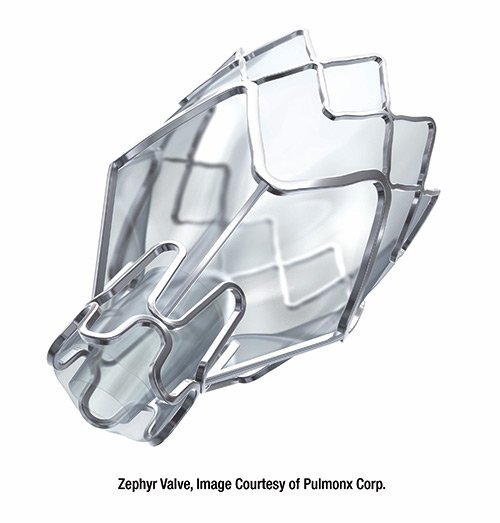Zephyr® Valves for Severe COPD and Emphysema
 The Zephyr Valve treatment helps patients breathe easier and do more without many of the risks associated with major surgery. The procedure is usually complete in under an hour and allows patients to enjoy a better quality of life.
The Zephyr Valve treatment helps patients breathe easier and do more without many of the risks associated with major surgery. The procedure is usually complete in under an hour and allows patients to enjoy a better quality of life.
How does the Zephyr Valve Work?
Many patients with severe COPD/emphysema suffer from hyperinflation of their lungs where air becomes trapped in the diseased sections of the lungs which makes it difficult to take in fresh air and causes severe shortness of breath. Breathing becomes inefficient and patients must work very hard just to breathe – making normal activities, like walking, eating or even bathing, difficult.
The Zephyr Valve reduces this hyperinflation by allowing trapped air to escape and preventing new air from entering that diseased lobe. This lets the healthier parts of the lung function better and results in patients being able to breathe more easily and experience less shortness of breath.
The valves are placed via bronchoscopy, with no incision or cutting, so these benefits are achieved without many of the risks of traditional surgical options. The procedure is usually complete in under an hour.
Zephyr® Endobronchial Valve FAQ
What is the Zephyr Endobronchial Valve (Zephyr Valve)?
The Zephyr Valve is the first FDA-approved, minimally invasive device available in the U.S. for treating patients with severe COPD (Chronic Obstructive Pulmonary Disease)/emphysema.
What are the Benefits of the Zephyr Valve?
In clinical studies patients treated with Zephyr Valves have been shown to:
- Breathe easier
- Be more active and energetic
- Enjoy a better quality of life
- Feel more confident leaving home
Who is the Zephyr Valve treatment for?
The Zephyr Valve is for patients with severe COPD/emphysema who consistently feel short of breath despite using COPD medications and/or oxygen. Generally, candidates for the Zephyr Valve treatment are patients who:
- Have a confirmed diagnosis of COPD or emphysema
- Have to stop to catch their breath often, even with taking their medication as directed
- Have reduced lung function (FEV1≤50% predicted)
What can Patients Expect?
Zephyr Valves are placed during a procedure that does not require any cutting or incisions. A typical Zephyr Valve procedure looks like this:
- Step 1 – The doctor will give the patient medicine to make them sleepy.
- Step 2 – A small tube with a camera, called a bronchoscope, will be inserted into your lungs through your nose or mouth.
- Step 3 – During the procedure your doctor will place on average 4 Zephyr Valves in the airways. The number of valves placed will depend on the individual anatomy of the patient’s airways and physician discretion.
- Step 4 – You will stay in the hospital for a minimum of 3 nights. Some patients who experience a complication may be required to stay longer.
- Step 5 – After the procedure, you will continue to use the medicines that your doctor has prescribed for your condition.
